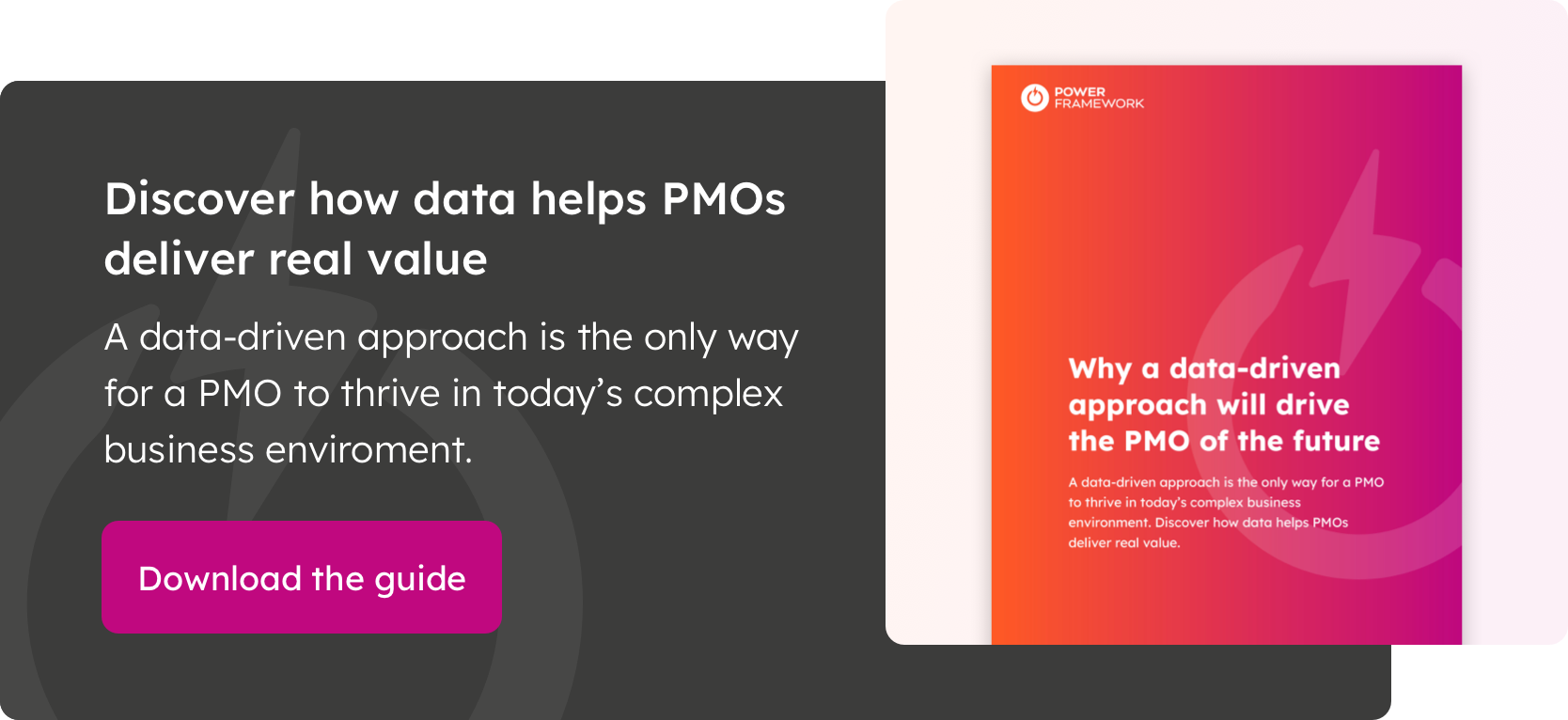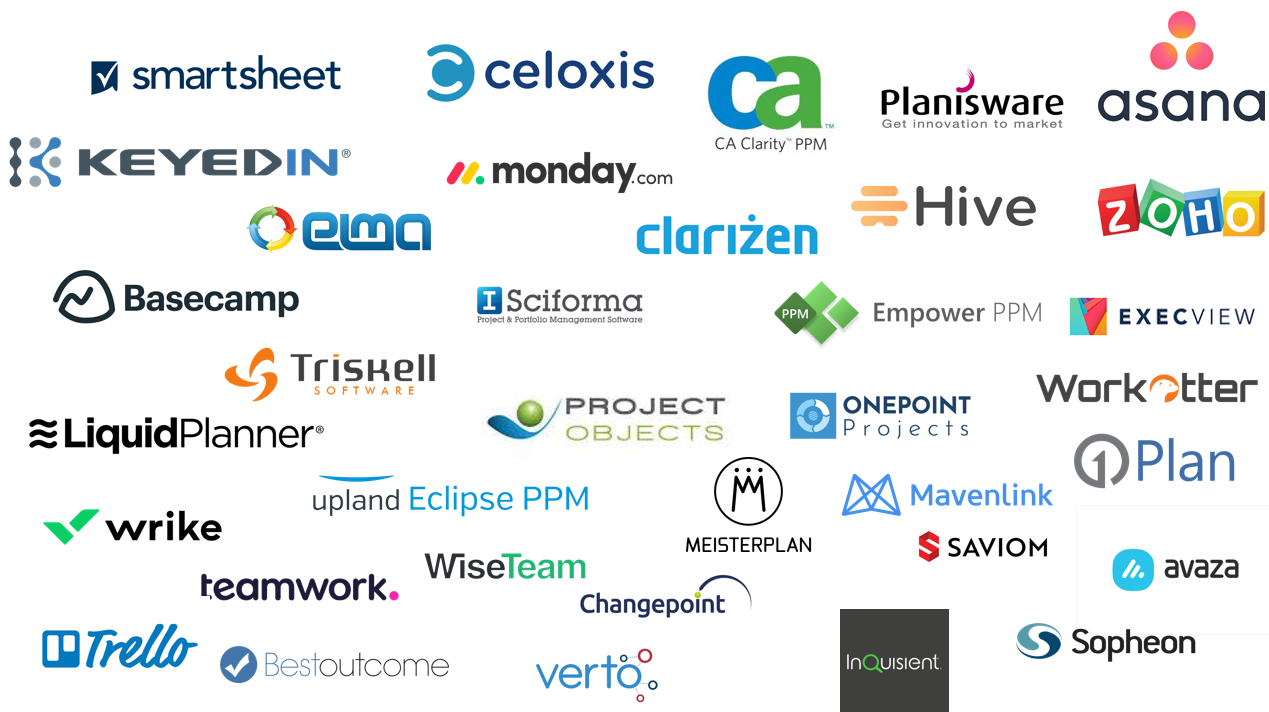Today’s organisations know they need high-quality data to deliver successful projects. And that requires team members to embrace the mindset, PPM tools, and processes to create a data-driven culture. How can we help them do this?
What do we mean by "data-driven"?
The term data-driven describes a business state where teams use data to power decision-making. Gut feelings and intuition don't bias the outcomes.
The aim of a data-driven culture is to empower employees to actively use data to enhance their daily work by making:
- Decisions more successful
- Initiatives more effective
- Competitive advantages larger
Establishing a data-driven culture means change
Becoming a data-driven PMO requires people to change the way they work, as well as changes in process and technology. For example, you might ask your teams to:
- Give up disconnected spreadsheets and project plans
- Work with new enterprise applications that capture and validate data and make it available for instant reporting
- Accept standardisation of tools and processes, when in the past they may have had personal freedom to work in whatever way they thought best
- Supply data they never captured in the past, such as entering timesheets
- Increase process maturity (i.e. deal with greater pressure to maintain data on time and to mandated quality standards)
- Rely less on others (such as a PMO) to review and correct data that they supply, as their data should now flow straight into organisational reports
- Accept the fact that others have better project visibility
- Adapt to greater process automation (such as system-based approvals)
But change can be hard.
Why are people resistant to change?
McKinsey estimates that around 70% of change programmes fail to achieve their goals, largely due to employee resistance and poor management.
You can invest in the most advanced tools on the market, but unless your team buys into your vision, you won’t see results.
Here are some common reasons why people resist change:
1. Unclear benefits
People may not understand why change is necessary and what benefits it will bring to the organisation, their team, or themselves. The resulting lack of conviction undermines their willingness to support change.
2. Change fatigue
Change fatigue is a real issue for companies that are transforming processes and tools in every department. This may increase workload for people, while not necessarily returning any benefits. Stress and disappointed expectations make people wary of future initiatives.
3. Cynicism
People may remember a similar initiative that failed - in the world of projects, this may be a project portfolio management software implementation that never delivered on its promise. Clearly, that makes it hard to feel confident that a new initiative will be any different, so people will be less inclined to support it.
4. Change specific resistance
People may identify inherent issues in the design of the change initiative. They may have real-world practical knowledge of issues that aren't addressed by the change or maybe they can see flaws in financial assumptions. Whatever the problem, if the entire idea of change doesn’t look feasible, then people have strong reasons to oppose it.
5. Fear
Impending change can induce fear in various ways. People may have concerns about their ability or capacity to adapt to change, doubting their own competence and skill. They may be scared of losing their position of seniority or of changing relationships. If they are an expert in the current toolset, they may be worried that this expertise will be of no value in the future.
6. Lack of leadership support
Successful organisational change begins at the top. Yet all too often, business leaders embark on radical change without supporting those on the front lines. They may use coercive measures to implement change, or not exhibit their own adoption of the change.
How do we overcome these obstacles?
Explain the benefits to the individual
Asking your team to adopt new processes and tools to create a data-driven culture can seem rather vague.
Outline the specific benefits of embracing a data-driven culture and take the time to explain how it will transform the way people work.
In particular, describe the 'what's in it for me' aspects of each stakeholder role with specific examples, addressing their current challenges. For project managers, the benefits might be:
- Significant time savings (e.g. through negating double entry of data, use of efficient and responsive modern applications to track their project data, automation of approval processes, etc.)
- Instant access to information (e.g. of task status and shared documents)
- Better online collaboration with team members (e.g. via Microsoft Teams)
- Greater attention to project needs (e.g. through risk and issue reporting being visible to the right people)
- Clarity of process and better guidance through systems that support the team's specific way of working
Looking for some inspiration on what the benefit cases may be for different stakeholder groups? Check out this webinar!
Show how you use data for organisational benefit
Help team members buy into data initiatives by explaining why you collect data, how you use it, and what the benefits are to the organisation.
For example, if people are sceptical about logging time, then they might be won over if you explain the positive impact like this:
- We will be able to assess how much time was actually needed for different project activities
- This will help us create more realistic estimates for future projects
- We'll have a greater chance of project success while reducing stress levels by not working towards unrealistic deadlines.
Choose the right tools
While becoming a data-driven organisation is very much about people and processes, it also requires the right tools. You can't become a data-driven organisation with a bunch of disconnected spreadsheets.
Your ideal tool will provide an enterprise database that will:
- Enforce your data standards and business rules
- Deliver dashboards and reports automatically
If your organisation has adopted Microsoft cloud, then there's a significant argument to place your tool into it using the Microsoft Power Platform.
Lead from the top
You need participation from every level to develop a data-driven culture. But the driving force behind that change should come from the top.
Executives must be seen to use the data that is now available and the insights that can be gleaned from it. They must lead in the 'storytelling' about what it means to the organisation and to them.
One of our customers, a senior director, once told this story to his team:
In the past, I didn't have up-to-date information about the state of projects and I was often caught out when communicating to the board about the progress of strategic initiatives. With this system and new process in place, I have all the details at my fingertips. I feel far more confident about the information I share with the board and this has increased our trust and reputation.
Training and support
Relevant training and ongoing support is crucial. It’s not enough to push new systems and dashboards on your team. Help them understand how to use your new tools and provide ongoing support to guide everyone through the change.
Apply change management best practice
The greater the change and the number of people that need to make it, the bigger the challenge and the greater the benefit of applying formal and proven change management best practices.
One of the best-known change methodologies is Prosci which is built around the ADKAR model. “ADKAR” is an acronym for the five outcomes an individual needs to achieve for a change to be successful:
- Awareness
- Desire
- Knowledge
- Ability
- Reinforcement
The ADKAR Model equips leaders with the right strategies and tools, and individuals with the right information, motivation, and ability to successfully move through changes in the organisation.
The model is a component of a three-phase process:
- Prepare approach
- Manage change
- Sustain outcomes
The process uses a range of tools, such as Readiness Assessment, Comms Plans, Sponsor Roadmaps, formal Coaching, and Training plans. You can use Workforce Analysis to understand different personas that will be affected by the change. A Change Network is documented to formally identify the people that will drive change at various organisational levels.
The benefits of a data-driven culture justify the investment
A data-driven approach is the only way for a project organisation to thrive in today's complex business environments. Check out our in-depth report.
Data-driven organisations wouldn’t be possible without cloud technology. Market-leading analytics tools like Power BI have made automation and machine learning available to everyone.
With the right training, support, and attitude, anyone can harness the power of data to solve business challenges and drive innovation.
Join the conversation with our PPM & PMO software experts on LinkedIn.





